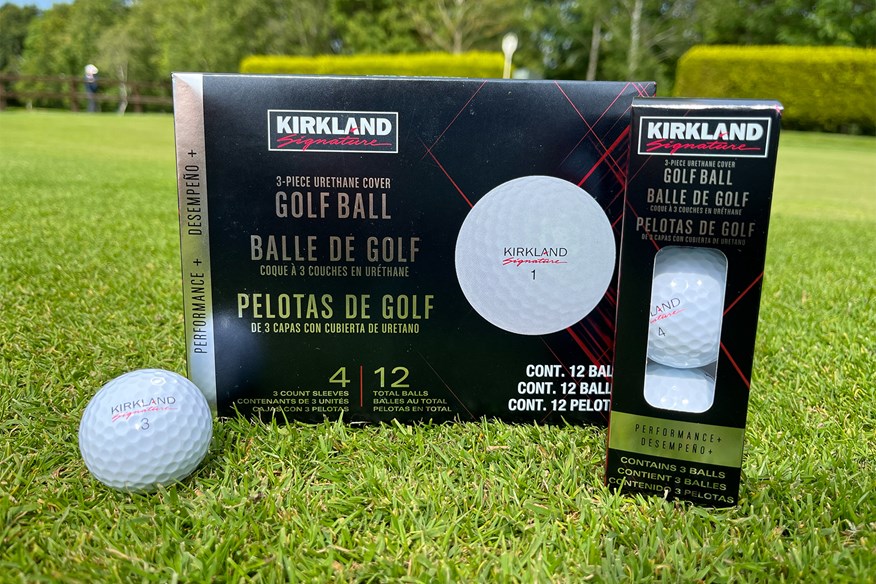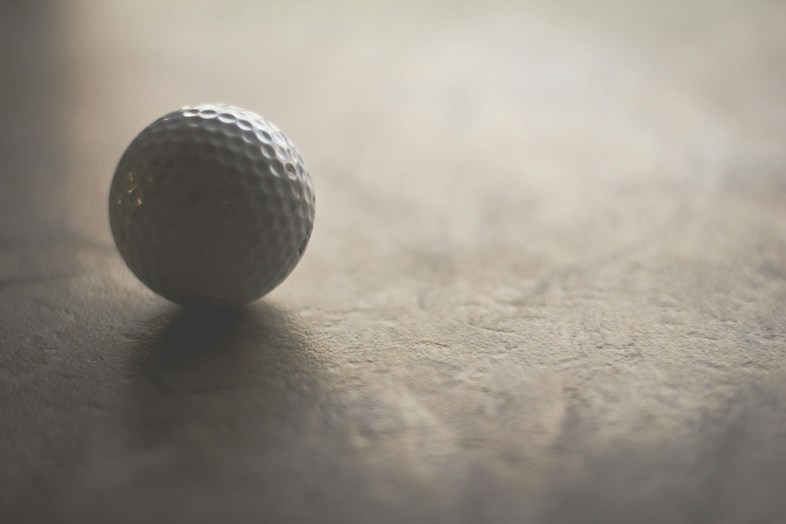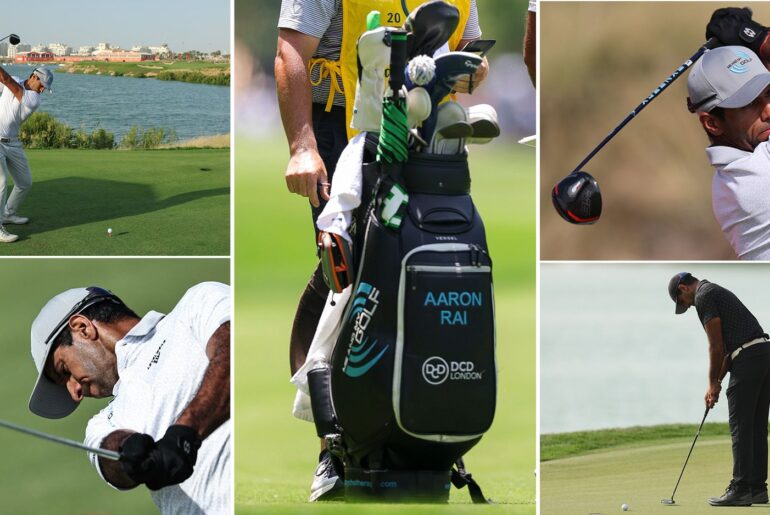Our robot golf ball test revealed five models that should be avoided.
The main focus of our annual robot golf ball test is to find you the best golf ball for your game. But, in doing that, we also find out what the worst golf balls are.
Sadly, one ball does have to be crowned the absolute worst. But that’s not to say that it absolutely bombed while the other 61 flourished.
We’ll focus on a handful of models that underperformed, and I’ll provide my insights into why I wouldn’t recommend any of them to any golfer.
 How we tested the golf balls
How we tested the golf balls
We tested 62 different golf balls on a $100,000 robot. This machine delivers exactly the same strike every time, which means the only variable in our test was the ball itself.
We tested every ball across five different shot types to get a complete picture of how the balls stacked up:
114mph driver – PGA Tour average
93mph driver – LPGA Tour and typical male club golfer
78mph driver – average female club golfer
7-iron – 80mph, which is club golfer average
56° wedge – hitting a 40-yard pitch shot
The key performance areas are:
Driver carry distance and ball speed
Approach play descent angle and carry distance consistency
Short game backspin
For a ball to be deemed “the worst golf ball”, we need to factor in all five different shot types, and it needs to have performed poorly in every area and scoring metric.
With that cleared up, let’s get into the numbers and see which golf ball, unfortunately, takes the honors as the worst golf ball of our 2025 robot test.
 What is the worst golf ball of 2025?
What is the worst golf ball of 2025?
The worst golf ball of 2025 is the Pinnacle Soft.
The Pinnacle Soft wasn’t at the back of the pack and being lapped by all 61 other models, but it is undoubtedly at the bottom of the pile with an average ranking in all scoring areas of 61.
The second-worst golf ball was a tie between the Maxfli SoftFli and Srixon UltiSoft, which both had an average ranking of 56 in the scoring areas detailed above.
The fourth and fifth-worst-performing golf balls of 2025 are the Wilson Duo Soft and Bridgestone e12 HiLaunch. The Duo Soft finished testing with an average ranking of 55, and the e12 HiLaunch with 54.
As you can see, the Pinnacle Soft isn’t completely detached from the rest of the pack; a handful of models underperformed. So, what numbers did all of these golf balls post? And, how far behind the best golf ball were they?
Driver – 78mph swing speed
Ranked by carry distance
Golf ballCarry distance (yds)Carry distance rankBall speed (mph)Ball speed rankTaylorMade TP5x163.61st114.31stMaxfli SoftFli159.251st112.254thBridgestone e12 HiLaunch158.756th111.958thWilson Duo Soft158.458th112.056thSrixon UltiSoft157.861st111.561stPinnacle Soft155.762nd110.762nd
The TaylorMade TP5x is the longest and fastest golf ball for slow swing speeds, which is why I added it here for comparison.
The SoftFli is over four yards shorter than the TP5x, but it’s the longest of the five worst golf balls from our robot test. The Pinnacle Soft is the shortest golf ball of the test, nearly 10 yards shorter than the TP5x – for most golfers that’s a full club difference.
Driver – 93mph swing speed
Ranked by carry distance
Golf ballCarry distance (yds)Carry distance rankBall speed (mph)Ball speed rankCallaway Chrome Tour210.81st134.72ndBridgestone e12 HiLaunch204.654th131.855thMaxfli SoftFli204.557th131.759thWilson Duo Soft203.859th131.856thSrixon UltiSoft201.961st130.561stPinnacle Soft200.662nd130.162nd
For golfers with an average swing speed, the Callaway Chrome Tour is the longest golf ball and second-fastest (only behind the TP5x for ball speed). The Pinnacle Soft is over 10 yards shorter than the Chrome Tour, and once again, the shortest golf ball.
The longest of the five worst golf balls is the Bridgestone e12 HiLaunch, which is four yards longer than the Pinnacle Soft, but over six yards shorter than the Chrome Tour.
Driver – 114mph swing speed
Ranked by carry distance
Golf ballCarry distance (yds)Carry distance rankBall speed (mph)Ball speed rankCallaway Chrome Tour275.41st165.11stBridgestone e12 HiLaunch265.754th159.357thWilson Duo Soft263.757th159.258thMaxfli SoftFli263.060th158.659thSrixon UltiSoft262.761st157.861stPinnacle Soft260.462nd157.862nd
The Chrome Tour is the longest and fastest golf ball for golfers with fast swing speeds, making it the longest golf ball of 2025. Sadly, the Pinnacle Soft brings up the rear once again, this time, 15 yards behind the Chrome Tour – that’s more than a club difference.
The Pinnacle Soft was detached from the rest of the pack by over two yards, which might not sound like a lot, but it’s the largest gap between two balls out of all 62.
Of the five worst-performing golf balls from our robot test, the e12 HiLaunch was the longest, over five yards longer than the Pinnacle Soft, but still 10 yards behind the Chrome Tour.
7-iron
Ranked by descent angle
Golf ballDescent angle (°)Descent angle rankBackspin (rpm)Backspin rankCarry distance consistency rankCarry distance (yds)Carry distance rankWilson Staff Model X45.41st4,78213th18th35th156.1Bridgestone e12 HiLaunch44.652nd4,20651st52nd157.025thSrixon UltiSoft44.455th4,16853rd41st156.134thWilson Duo Soft44.357th4,01957th51st158.38thMaxfli SoftFli44.259th4,01758th55th158.47thPinnacle Soft44.062nd4,10956th60th155.548th
The Wilson Staff Model X is the golf ball that lands with the steepest descent angle (45.4°) of all 62, while once again, the Pinnacle Soft is at the bottom of the pile (44.0°), nearly 1.5° shallower than the No.1 ball of the entire test.
A degree and a half might not sound like an awful lot, but factor in the drop in spin – over 700rpm – and the Pinnacle Soft doesn’t make any appeal if you’re wanting to improve your proximity to hole and greens in regulation.
Backspin with the 7-iron shot sees the Pinancle Soft move out of last place for the first time – albeit only into 56th. However, there are lower-spinning models. None of the five worst balls of our robot test land with a particularly steep descent angle (all below the test average), and it’s the same story with spin.
The Maxfli SoftFli is the lowest-spinning of the five (4,017rpm) and the 58th lowest-spinning model of the entire test.
40-yard pitch
Ranked by backspin
Golf ballBackspin (rpm)Backspin rankCallaway Chrome Tour X6,3431stWilson Duo Soft5,44253rdBridgestone e12 HiLaunch5,43754thMaxfli SoftFli5,43255thPinnacle Soft5,32758thSrixon UltiSoft5,28660th
The highest-spinning golf ball at the 40-yard pitch shot was the Callaway Chrome Tour X, and it was roughly 1,000rpm higher-spinning than the five worst golf balls. All five of the worst balls were below the backspin test average by over 250rpm – even with the Maxfli StraightFli and TaylorMade Distance+ bringing the average down massively.
Which golf balls should you use instead?
If you’re currently using one of the five golf balls we’ve discussed in this article, I recommend you start using a different model. I’m going to list a couple below that are of a similar price and will give you more performance benefits.
Best value golf ball of the entire robot test
Best overall two-piece golf ball
The Bridgestone e12 Speed is arguably the biggest surprise package of the entire test, for all of the right reasons. This is by far the best two-piece golf ball, and one of the best golf balls out of all 62 tested.
Let’s start by running through all of the e12 Speed’s awards. Gold medal for tee to green performance at 114mph, 93mph, and 78mph, off-the-tee performance, and approach play performance.
The only area where the e12 Speed didn’t rank is short game performance, where it finished in fourth, by 9rpm (5,951).
The e12 Speed is the highest-performing Bridgestone golf ball, factoring in how it performed in every area. Its best performance has to be off the tee. At 114mph, this golf ball was 2.4 yards longer and 0.8mph faster than the second-longest and second-fastest model, and fourth-longest overall (273.9yds).
At 93mph, the e12 Speed is the second longest (209.7yds) and fastest (134.1mph) two-piece golf ball. But, at 78mph, this golf ball is back at the top of the table for both (161.3yds and 113.2mph).
Combine that performance with its dominating approach play performance, and not only do you have an amazing golf ball off the tee, but you have a fantastic golf ball from tee to green.
The e12 Speed is a golf ball I urge every golfer to consider. This is hands down the best value golf ball in the entire test, and as one of the best performers of all 62 models tested, what harm do you have in giving it a go?
On-course verdict
I was extremely surprised by the on-course performance of the Bridgestone e12 Speed, and having played with this golf ball on a couple of occasions, it has never disappointed.
The first time I played with the e12 Speed had me questioning if it definitely is a two-piece golf ball because it performs much closer to other three-piece Tour-level models.
The Bridgestone golf ball I’ like most’m most fond of is the Tour B XS, and I think this performs very similarly – if not better.
The feel is slightly firmer than the Tour B XS, which is something I appreciate, and it does deliver more feedback and response throughout the bag.
Overall, I’m very impressed with the tee to green performance of the e12 Speed. Despite being a two-piece model, I wouldn’t be quick to dismiss it.
Pros & Cons Specs Features
Pros Perfroms more like a premium golf ballOutstanding tee to green performanceAmazing feedback and response Cons Very difficult to criticize Carry distance (yds) Driver 114mph – 273.9 | Driver 93mph – 210 | Driver 78mph – 161.3 | 7-iron – 157.6 Ball speed (mph) Driver 114mph – 164 | Driver 93mph – 134.1 | Driver 78mph – 113.2 | 7-iron – 109.2 Backspin (rpm) Driver 114mph – 2,680 | Driver 93mph – 2,574 | Driver 78mph – 2,317 | 7-iron – 4,467 | Pitch – 5,951 Launch angle (°) Driver 114mph – 11.4 | Driver 93mph – 12.9 | Driver 78mph – 14.1 | 7-iron – 21.3 | Pitch – 30.7 Descent angle (°) Driver 114mph – 37.6 | Driver 93mph – 31.8 | Driver 78mph – 27 | 7-iron – 45.1 | Pitch – 36 Peak height (yds) Driver 114mph – 33 | Driver 93mph – 22.3 | Driver 78mph – 15.5 | 7-iron – 30 | Pitch – 6.9 Compression (psi) 103 Optimal Flight SystemFast gradational coreMindSet technology330 dimples2-Piece constructionAvailable in white only
A brilliant budget option
I think it’s fair to say we were expecting the Callaway Warbird Distance+ to be a very middle-of-the-road two-piece golf ball. We definitely weren’t expecting this golf ball to perform as well as it has.
The Warbird Distance+ is Callaway’s cheapest golf ball, but it certainly doesn’t perform as though it is. This model scooped up the second-most awards in the two-piece category.
Tee to green performance is incredibly strong at all three swing speeds. The Warbird Distance+ won silver at 93mph and 78mph, and bronze at 114mph. Distance is definitely a strong factor, being the third-best golf ball off the tee in this category.
However, this golf ball isn’t purely a distance model (despite it being in its name). For short game performance, the Warbird Distance+ is the second-highest-spinning two-piece model (5,963rpm) and the third-highest-spinning Callaway golf ball.
We’re really impressed by the overall performance of the Warbird Distance+. It’s firmly put this golf ball on our radar, and with its test results, it should be for you, too!
On-course verdict
I didn’t have particularly high hopes for the Callaway Warbird Distance+ given its price, construction, and name, but I’m happy to have been proven wrong.
The Warbird Distance+ doesn’t feel the greatest. It’s slightly clicky and clunky, which doesn’t make the feedback and response very pleasant, but if you can look past that, this is a solid golf ball from tee to green.
Despite being a distance golf ball, the Warbird Distance+ offers much more than solely distance. This golf ball produces high-spin when attacking pins with an iron and wedge – something you don’t always expect from a distance golf ball, but it’s always appreciated.
Although the Warbird Distance+ offers more than distance, distance is very impressive with this model, thanks to the reduced spin. The carry distance is long, but the ball continues to roll a long way, delivering amazing total distance.
The Warbird Distance+ might not jump out as a must-have golf ball, but you won’t be disappointed if you give it a go – I most certainly wasn’t.
Pros & Cons Specs Features
Pros Solid tee to green performanceSurprisingly strong short-game performanceImpressive distance Carry distance (yds) Driver 114mph – 270.9 | Driver 93mph – 209.2 | Driver 78mph – 161.3 | 7-iron – 157.9 Ball speed (mph) Driver 114mph – 163 | Driver 93mph – 133.7 | Driver 78mph – 113 | 7-iron – 108.7 Backspin (rpm) Driver 114mph – 2,683 | Driver 93mph – 2,611 | Driver 78mph – 2,346 | 7-iron – 4,273 | Pitch – 5,963 Launch angle (°) Driver 114mph – 11.1 | Driver 93mph – 13 | Driver 78mph – 14.2 | 7-iron – 21.6 | Pitch – 30.7 Descent angle (°) Driver 114mph – 36.8 | Driver 93mph – 32.2 | Driver 78mph – 27.3 | 7-iron – 44.9 | Pitch – 36.1 Peak height (yds) Driver 114mph – 31.7 | Driver 93mph – 22.5 | Driver 78mph – 15.6 | 7-iron – 29.9 | Pitch – 6.9 Compression (psi) 92 Extra-large, high-energy coreHex aerodynamics332 dimples2-Piece constructionAvailable in white and yellow
Excellent value for a three-piece urethane model
Best for high-spin and control

Robot test verdict
Kirkland golf balls are known for being high-spinning. The V2.0 was, and so is the V3.0. That’s not an issue if you struggle to get the ball in the air or find it difficult to hit and hold greens. It also means the Signature V3.0 is amazing around the greens.
The Signature V3.0 is the gold medal winner for short game performance, in this category, generating 6,050rpm. Of all 62 golf balls tested, it’s the seventh-highest-spinning golf ball.
Spin persists throughout the bag, and with the 7-iron shot, the Signature V3.0 is once again the highest-spinning three-piece club golfer model (4,861rpm). It also lands with the steepest descent angle (45°).
You might think the high-spinning nature will hurt how the V3.0 performs off the tee, but is that the case? Definitely not. The V3.0 is the bronze medal winner for off-the-tee performance.
It does generate a lot of spin, but it’s also long and fast at all three swing speeds. At the fastest swing speed, it’s the third-longest (271yds) and fastest (163.5mph), at the moderate swing speed, it’s the third-longest (208yds) and fastest (133.6mph), and at the slower swing speed, it’s the third-longest and fourth-fastest (112.8mph).
With the Kirkland Signature V3.0, you are signing yourself up to play with a high-spin golf ball, but if you need spin, it’s one of the best models you can play with.
On-course verdict
Over the years, these golf balls have been highly regarded by many golfers and heavily scrutinised by others. Kirkland’s Signature three-piece golf balls are known for delivering high spin, and this is no different with their V3.0, as it ranks among the best high-spin golf balls.
The biggest issue the V3.0 has is that its spin compromises distance, but for some golfers, that won’t be an issue whatsoever.
When I took this ball out on the course, I couldn’t criticise its distance in the long game, but then again, high-spin golf balls suit my game.
I’m a big believer that for the majority of golfers, spin is your friend. You’re guaranteed a golf ball that easily generates spin by playing with the V3.0. Therefore, I believe that more golfers would benefit from playing with this golf ball than not playing with this golf ball.
I’m not normally a fan of soft-feeling golf balls, but I must say that the V3.0 feels good off the club face. I wouldn’t say that the response from this golf ball is particularly strong throughout the bag, but around the greens, there is a pleasant sensation when you clip the ball cleanly – something I think most golfers appreciate.
I think the Kirkland Signature V3.0 is a very strong golf ball. I would never expect to see it played on Tour, but for amateur golfers, it’s definitely one to consider. If you struggle to generate spin or if you just enjoy having a high-spinning golf ball, then it’s a fantastic option.
Read our full Kirkland Signature V3.0 golf ball review.
Pros & Cons Specs Features
Pros Amazing price per ball considering the qualityCombines soft feel, long distance, and high spinImpressive consistent ball flight Cons Don’t expect optimal carry distance Carry distance (yds) Driver 114mph – 271 | Driver 93mph – 208 | Driver 78mph – 160.5 | 7-iron – 154.3 Ball speed (mph) Driver 114mph – 163.5 | Driver 93mph – 133.6 | Driver 78mph – 112.8 | 7-iron – 108.6 Backspin (rpm) Driver 114mph – 2,873 | Driver 93mph – 2,734 | Driver 78mph – 2,572 | 7-iron – 4,861 | Pitch – 6,050 Launch angle (°) Driver 114mph – 11.1 | Driver 93mph – 12.7 | Driver 78mph – 13.9 | 7-iron – 20.7 | Pitch – 30 Descent angle (°) Driver 114mph – 38.3 | Driver 93mph – 32.3 | Driver 78mph – 27.7 | 7-iron – 45 | Pitch – 35.1 Peak height (yds) Driver 114mph – 33.2 | Driver 93mph – 22.3 | Driver 78mph – 15.6 | 7-iron – 29.1 | Pitch – 6.5 Compression (psi) 107 Increased core sizeMantle with new proprietary coverProprietary TPU with improved scuff resistance and impact enduranceModified dimple depth for optimized flight height338 dimples3-Piece constructionAvailable in white only







